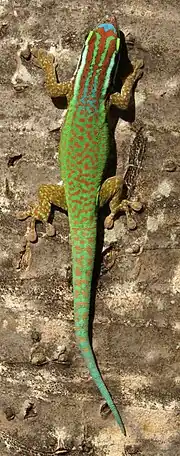| Reunion Island ornate day gecko | |
|---|---|
 | |
| Scientific classification | |
| Domain: | Eukaryota |
| Kingdom: | Animalia |
| Phylum: | Chordata |
| Class: | Reptilia |
| Order: | Squamata |
| Family: | Gekkonidae |
| Genus: | Phelsuma |
| Species: | P. inexpectata |
| Binomial name | |
| Phelsuma inexpectata Mertens, 1966 | |
 | |
| Approximate distribution
Range
Depicted: Reunion Island, Southern Africa | |
| Synonyms | |
| |
Reunion Island ornate day gecko or Manapany day gecko (Phelsuma inexpectata) is a critically endangered diurnal species of gecko. It occurs only on the island of Réunion in the Indian Ocean, typically inhabits trees, and feeds on insects and nectar.
Description
This lizard is one of the smallest day geckos. It can reach a total length of about 12 cm at most. The body colour is dark green. Three red stripes extend from the snout to the neck. From behind the eye, a thick brown stripe and a thin green-white extend to above the front leg. The snout is partly dark blue. The back is covered with reddish-coloured dots, which are greatly reduced in females. The ventral side is off-white.
Distribution and habitat
This species is endemic to Réunion. It is found in the coastal areas in the region of Manapany-Les-Bains and St.-Joseph. This coastal ecosystem is among the most threatened on the island, and the gecko's habitat is severely fragmented by urbanization and agriculture.[1] It typically lives on trees such as papaya, banana, pandanus and other pantropic vegetation. The geckos also inhabit human dwellings and have been spotted on postboxes and fences. This biotope is relatively dry and hot.
Behaviour
Feeding
They feed on various insects and other invertebrates. They also like to lick soft sweet fruit, pollen and nectar.
Breeding
At a temperature of 28 °C, the young will hatch after approximately 50–52 days. The juveniles measure around 48 mm.
Status and conservation
The species is critically endangered, with a population of 3-5 thousand in 2011. The population is shrinking rapidly: in 1995, it was estimated at 5-10 thousand.[1] It is listed in CITES Appendix II.[2]
Captivity
The geckos can be quite shy in captivity and are also surprisingly speedy. There is no information on the effect of the pet trade on the population. They are captive-bred by some dealers.[3]
References
- 1 2 3 SANCHEZ, Mickaël; PROBST, Jean-Michel; DESO, Grégory (2009). "Phelsuma inexpectata Mertens, 1966 (Squamata: Gekkonidae) sur l'île de La Réunion: écologie, répartition et menaces". Bulletin de la Société herpétologique de France (132): 43–69. Retrieved 2017-04-21.
- ↑ , Species+, 24 November, 2011
- ↑ Breeding Endangered Geckos, editor's interview with Matt Schaefer, July 23, 2013
- Henkel, F.-W. and W. Schmidt (1995) Amphibien und Reptilien Madagaskars, der Maskarenen, Seychellen und Komoren. Ulmer Stuttgart. ISBN 3-8001-7323-9
- McKeown, Sean (1993) The general care and maintenance of day geckos. Advanced Vivarium Systems, Lakeside CA.
